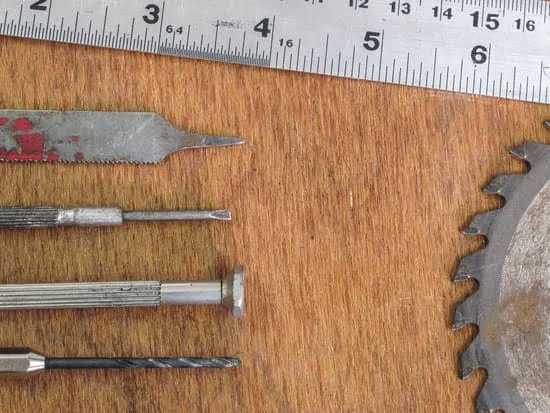What does a shaper do in woodworking? A shaper is a versatile and essential tool in the world of woodworking, often used to create intricate designs, moldings, and edges on wood. In this article, we will delve into the purpose of a shaper and its significance in the craft of woodworking.
Woodworking enthusiasts and professionals alike rely on shapers for their ability to efficiently shape wood with precision and detail. Whether it’s crafting decorative trimmings or creating custom furniture pieces, a shaper offers endless possibilities for woodworking projects.
This introductory section will provide an overview of the role of a shaper in woodworking, highlighting its functionality and impact on the craft. We will explore the basics of a shaper, different types available, safety protocols when using one, various techniques for using a shaper effectively, real-life examples of shaper applications, maintenance tips, and guidance on choosing the right shaper for specific tasks and projects. Join us as we uncover the world of shaping wood with this powerful tool.
Understanding the Basics
A shaper is an essential tool in woodworking, used for shaping wood and creating various profiles and designs. Understanding the basics of a shaper, including its different components and how they function, is crucial for anyone looking to master this woodworking tool.
Components of a Shaper
The main components of a shaper include the motor, spindle, cutter head, fences, hold-downs, and adjustable guides. The motor provides the power needed to rotate the spindle, which holds the cutter head in place. Fences and hold-downs are used to secure the workpiece in place, while adjustable guides allow for precise measurements and cuts.
How They Function
The motor of a shaper rotates the spindle at high speeds, causing the cutter head to spin and cut into the wood. By adjusting the height and position of the cutter head, different profiles and shapes can be achieved. Fences help guide the wood along the cutter head, while hold-downs keep it firmly in place during shaping. Adjustable guides ensure accuracy and precision in shaping wood.
Understanding these components and their functions is crucial for safe and effective use of a shaper in woodworking projects.
Importance of Understanding Basics
Knowing how each component of a shaper works is essential for using it effectively and safely. It allows woodworkers to make precise cuts, create intricate designs, and avoid accidents. Whether working on simple or complex projects, understanding the basics of a shaper is fundamental to achieving high-quality results in woodworking.
Types of Shapers
A shaper is a crucial tool in woodworking, allowing craftsmen to create intricate designs and shapes in wood. There are different types of shapers available, each with its own unique features and uses that cater to specific woodworking tasks. Understanding the different types of shapers and their respective uses is essential for woodworkers who want to achieve precision and efficiency in their projects.
One type of shaper commonly used in woodworking is the spindle shaper, which operates with a vertically mounted spindle for shaping wood. This type of shaper is highly versatile and can accommodate various cutter heads, making it suitable for tasks such as edge profiling, molding, and tenoning.
Another type is the sliding table shaper, which features a table that moves back and forth, allowing for smooth and precise shaping of larger workpieces. The tilting arbor shaper, on the other hand, offers the flexibility of adjusting the angle of the spindle to create beveled edges or angled cuts.
Woodworkers must carefully consider the specific tasks they need to accomplish when choosing a shaper. For instance, if they frequently work on large panels or require angled cuts, a sliding table or tilting arbor shaper may be more suitable. Alternatively, those who focus on detailed molding work might prefer a spindle shaper for its versatility in accommodating different cutter heads.
When selecting a shaper for woodworking projects, it’s essential to assess the features and capabilities that align with individual needs. Considerations such as horsepower, spindle speed, fence adjustability, and compatibility with accessories play a significant role in determining the most appropriate type of shaper for a particular task.
| Type of Shaper | Common Uses |
|---|---|
| Spindle Shaper | Edge profiling, molding, tenoning |
| Sliding Table Shaper | Precise shaping of large workpieces |
| Tilting Arbor Shaper | Creating beveled edges or angled cuts |
Shaper Safety
When working with a shaper in woodworking, it is crucial to prioritize safety at all times. A shaper is a powerful and versatile tool that can shape wood with precision, but if not used properly, it can pose serious risks to the operator. Understanding and implementing safety protocols when using a shaper is essential to prevent accidents and injuries.
One of the most important safety measures when operating a shaper is wearing appropriate personal protective equipment (PPE). This includes safety goggles to protect the eyes from flying debris, hearing protection to reduce exposure to loud noise, and proper clothing to avoid getting entangled in the machinery. Additionally, it is strongly advised to use push sticks or feather boards when feeding material into the shaper to keep hands at a safe distance from the cutting head.
Another key aspect of shaper safety is ensuring that the machine is properly maintained and set up before use. This involves checking for any loose or damaged components, ensuring that all guards are in place, and verifying that the material being shaped is securely held in position. It’s also important to follow the manufacturer’s recommendations for speed settings and cutter positioning to prevent kickback and other potential hazards.
In addition to these measures, operators should be well-trained on how to use a shaper safely. Understanding the correct feeding techniques, maintaining focus while operating the machinery, and knowing how to react in case of an emergency are all integral parts of using a shaper effectively without compromising on safety.
| Shaper Safety Measures | Importance |
|---|---|
| Wearing PPE | Protects against flying debris and loud noise |
| Maintenance and Setup | Prevents accidents caused by loose or damaged components |
| Proper Training | Key for understanding safe operation and emergency procedures |
Shaper Techniques
Woodworking projects can greatly benefit from the use of a shaper, as it provides woodworkers with a versatile tool for shaping and molding wood. Understanding the various techniques and tips for using a shaper in woodworking projects is essential to achieving precision and quality in the final output.
Utilizing Different Shaper Cutters
One of the key techniques in using a shaper is selecting the right cutter for the specific woodworking task at hand. Whether it be a raised panel, edge detail, or joinery cut, different cutters produce different effects on the wood. Woodworkers must understand the characteristics and capabilities of each type of cutter to achieve their desired results.
Proper Feeding Techniques
Effective feeding techniques are crucial when using a shaper. It is important to maintain proper control and pressure while feeding the wood through the machine to ensure smooth and accurate cuts. Understanding how to safely and steadily feed the wood into the shaper will result in clean edges and precise shapes.
Using Jigs and Fixtures
Incorporating jigs and fixtures can enhance the capabilities of a shaper, allowing woodworkers to create intricate shapes and designs with ease. Jigs provide stability and support, enabling consistent and repeatable cuts. Additionally, fixtures can help secure workpieces in place, reducing the risk of accidents while operating the shaper.
By mastering these techniques and implementing best practices, woodworkers can maximize the potential of a shaper in their woodworking projects, resulting in professional-quality craftsmanship that meets their exact specifications.
Examples of Shaper Applications
There are countless examples of the versatile and essential role that a shaper plays in woodworking. From intricate moldings and trim work to detailed joinery and custom paneling, a shaper is a crucial tool for creating impeccable woodworking pieces. Below are some real-life applications and projects where a shaper was used to achieve stunning results:
- Custom Molding: One of the most common uses for a shaper is in crafting custom molding for home renovations and furniture making. Whether it’s replicating historic profiles or creating unique designs, a shaper excels at producing precise and consistent moldings that add decorative touches to any project.
- Raised Panel Doors: Shapers are indispensable for creating raised panel doors, which require precision milling of the stiles, rails, and panels. The ability to produce clean, crisp profiles on these components is paramount in achieving professional-looking doors for cabinetry and furniture.
- Specialty Joints: Joinery such as tongue and groove, cope and stick, and lock miter joints are effortlessly executed with a shaper. These strong and visually appealing joints enhance the structural integrity of woodworking pieces while adding aesthetic value.
In each of these applications, the utilization of a shaper enables woodworkers to elevate their craftsmanship by achieving results that are simply not attainable using other tools or methods. The versatility and precision offered by this woodworking machine make it an indispensable asset in any workshop.
Moreover, the use of a shaper allows woodworkers to exercise creativity while bringing their design visions to life. Whether it’s through intricate details on furniture or ornate embellishments on architectural elements, the capabilities of a shaper empower craftsmen to push the boundaries of what can be achieved in woodworking.
Ultimately, these examples highlight how integral a shaper is in executing high-quality woodworking projects with exceptional detail and finesse. By utilizing this powerful tool effectively, woodworkers can elevate their creations to new levels of artistry and craftsmanship.
Maintenance and Care
Proper maintenance and care are crucial for ensuring the longevity and optimal performance of a shaper in woodworking. By following some simple guidelines, woodworkers can preserve their equipment and continue to produce high-quality pieces. Regular maintenance not only extends the lifespan of the shaper but also contributes to safety in the workshop.
One key aspect of maintaining a shaper is keeping it clean. Sawdust and debris can build up over time, leading to issues with the machine’s performance. It is important to regularly clean all parts of the shaper, including the cutting head, fence, and table. This can be done using a brush or vacuum to remove any sawdust or particles that may have accumulated during use.
In addition to keeping it clean, regular inspection of the shaper is essential for identifying any signs of wear or damage. This includes checking for loose or damaged parts, as well as ensuring that all components are properly lubricated. Proper lubrication prevents friction and ensures smooth operation.
By maintaining a regular schedule of inspection and lubrication, woodworkers can address potential issues before they become larger problems, ultimately extending the life of their shaper. Understanding how to properly maintain and care for a shaper is essential in optimizing its performance and ensuring its longevity in woodworking projects.
Choosing the Right Shaper
When it comes to woodworking, choosing the right shaper is essential for achieving the best results in your projects. Here are some tips for selecting the appropriate shaper for specific woodworking tasks and projects:
- Consider the size and capacity: The size of the shaper and its capacity will determine the type of projects it can handle. Larger, more powerful shapers are suitable for heavy-duty work, while smaller ones are better for more delicate tasks.
- Look at the spindle speed: Different shapers have varying spindle speeds, which can affect the quality of the cuts. High-speed spindles are ideal for finer details and smoother finishes, while lower speeds are better for larger cuts.
- Check the horsepower: The horsepower of a shaper determines its cutting capabilities. Higher horsepower allows for more precision and versatility in handling different types of wood.
It’s also important to consider the type of cutters and accessories that come with the shaper. Some shapers may come with a variety of cutter heads and fences, which can expand their functionality and allow for more intricate designs.
In addition to these technical considerations, it’s crucial to think about your specific woodworking needs and projects. Are you primarily working on cabinetry, furniture, or custom millwork? Understanding what type of work you’ll be doing will help you make an informed decision about which shaper is best suited for your requirements.
Ultimately, investing in a high-quality shaper that aligns with your woodworking goals will not only enhance your craftsmanship but also ensure a safer and more efficient working environment. Knowing what does a shaper do in woodworking is just as important as knowing how to choose one that fits your individual needs.
Conclusion
In conclusion, the shaper is a versatile and essential tool in woodworking, offering woodworkers a means to create intricate designs and precise cuts with ease. From understanding the basics of its components to exploring various techniques and applications, it is evident that the shaper plays a significant role in shaping wood for different projects.
Its impact on the craft of woodworking cannot be overstated, as it enables artisans to achieve highly detailed and polished results that may not be easily attainable with other tools.
One of the most important aspects of utilizing a shaper is ensuring safety protocols are followed at all times. By adhering to safety guidelines and operating the shaper with caution, woodworkers can minimize the risk of accidents and injuries while maximizing their productivity. Furthermore, proper maintenance and care for the shaper are crucial in maintaining its longevity and optimal performance. By taking care of this valuable tool, woodworkers can continue to rely on it for their future projects.
When choosing the right shaper for specific woodworking tasks and projects, it’s essential to consider factors such as size, power, speed control, and available accessories. Selecting the appropriate shaper will not only enhance efficiency but also contribute to achieving high-quality results in woodworking endeavors. Overall, what does a shaper do in woodworking goes beyond mere functionality; it empowers artisans to unleash their creativity and precision when working with wood.
Frequently Asked Questions
Is a Shaper Better Than a Router?
Whether a shaper is better than a router largely depends on the specific needs of the user. While a shaper is generally more powerful and versatile for larger-scale woodworking tasks, a router may be more suitable for smaller DIY projects or intricate detailing.
What Does Shaper Do?
A shaper is a woodworking tool used to cut and shape wood, similar to a router but typically more powerful and capable of handling larger pieces of material. It can create grooves, edges, and profiles in wood with precision and efficiency.
Do I Need a Wood Shaper?
Whether you need a wood shaper depends on the scale and complexity of your woodworking projects. If you frequently work with large pieces of wood or require more heavy-duty shaping capabilities, investing in a wood shaper may be beneficial. However, for smaller projects or occasional use, a router may suffice.

Hi everyone! I’m a woodworker and blogger, and this is my woodworking blog. In my blog, I share tips and tricks for woodworkers of all skill levels, as well as project ideas that you can try yourself.





